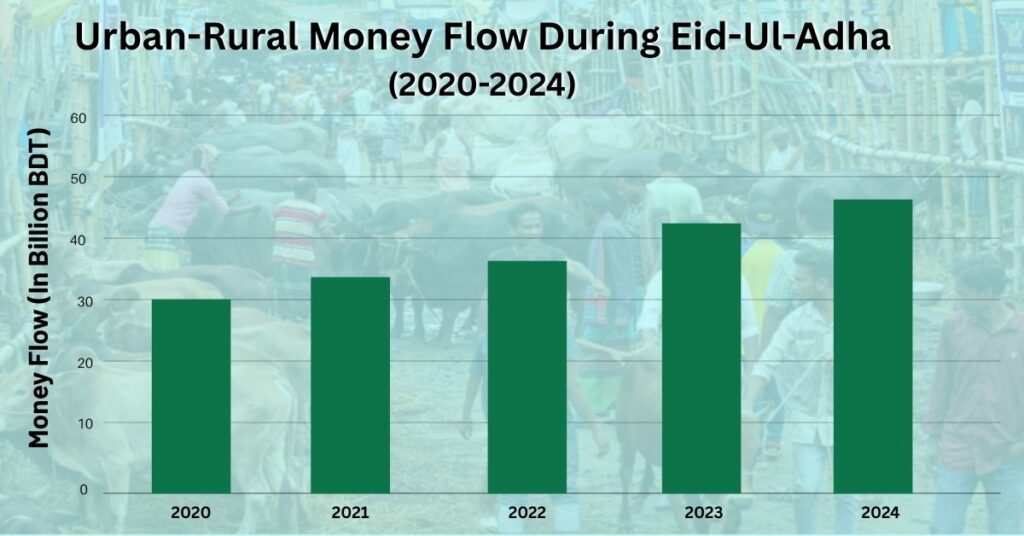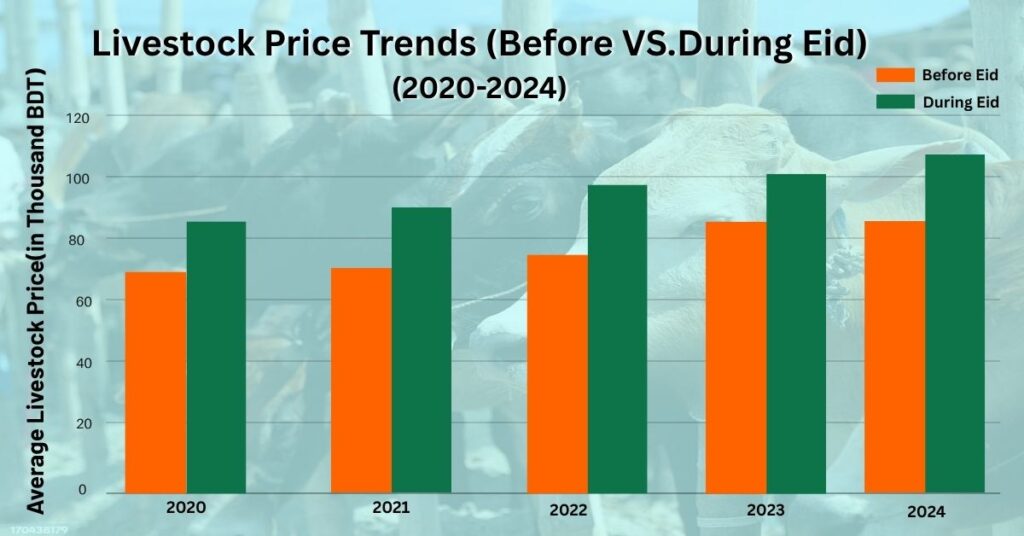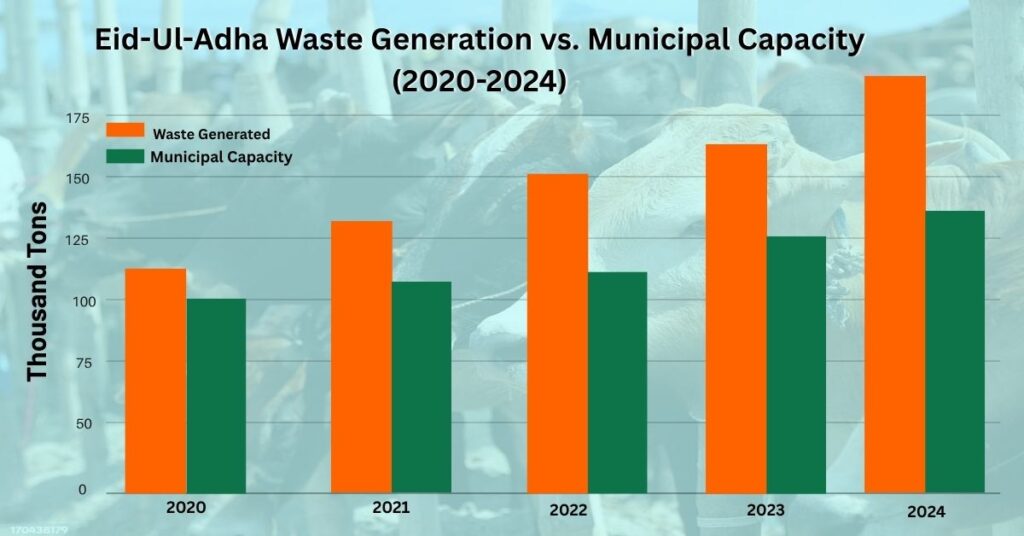1.Introduction
In Muslim ritual, they celebrate two main festivals, one is Eid-Ul-Fitr and another is Eid-Ul-Adha. Eid-Ul-Fitr come after Ramadan and Eid-Ul-Adha is feast of sacrifice. Eid-Ul-Fitr mainly remain us the story of prophet Ibrahim’s unwavering faith and willingness to sacrifice his beloved son in obedience for Allah. From the story it become ritual for all Muslims to sacrifice animals, such as cattle, goat, sheep and camels. Allah see how far his servant can go for getting his obedience.
This festival is a powerful driver so large-scale economic activity especially for major-Muslim countries. This time it sparks a massive seasonal demand in several sectors, such as livestock sector, influencing agriculture, transportation, commerce and services.
Eid-Ul-Adha Supply Chain is a temporary but complex system that stretches from rural livestock farms to urban sacrificial grounds. In this part, involves various stages such as reading and fattening of livestock by farmer. They sale and purchase in local markets or via intermediaries, transportation to urban centers or design slaughtering areas. As any part has it’s economic and social impact this Eid-Ul-Adha supply chain also have not only economic impact but also has several impact.
2. Understanding The Eid-Ul-Adha Supply Chain
For understanding Eid-Ul-Adha supply chain, we need to understand what is it and how it works. As we know Eid-Ul-Adha is a especially event for every Muslim. And in this festive season people have the opportunity to earn money from different sectors.
Eid-Ul-Adha supply chain means interconnected network of activities, resources and stakeholders involved in bringing sacrificial animals from their rearing to the point of sacrifice and the subsequent and distribution of the meat. It is mandatory to fulfill the religious obligation of sacrifice a d the associated customs.
Read More: Eid-Ul-Adha: A Holy Tradition and Its Socioeconomic Dimensions
2.1.Livestock Farming
Livestock farming means the practice of raising and managing domesticated animals for various purposes, primarily food and fiber production. Especially in rural region being preparing animals months in advance. Not it’s difficult to find in town areas. Livestock farmers invest in each and every part which is helpful for animals such as, feed veterinary care and labor to ensure healthy animals are ready for sale. For economic activity this stage is important and it provide agricultural and services.
2.2.Transport and Logistics
After all these stuffs After all these preparation, animals are ready for sale and for carrying them from one place to another they must need be transported. They carry their animal from farms to urban markets and this segment involves truck owners, drivers, loading laborers and maintenance services.
2.3.Temporary Cattle Market(Haats)
As it is a festive of Eid so cattle market is mandatory for every places. In Urban areas people set up temporary cattle markets and this markets are established under municipal or private arrangements. This markets helps people to get cattle’s in their areas and these markets are economic hubs, attracting buyers and sellers from diverse backgrounds. They also set up many food stalls, veterinary stations and security services thrive.
2.4.Sale and Purchase Process
During Eid-Ul-Adha for cattle, the sale and purchase process involves traditional markets and emerging digital platforms. Buyers can select their preferable cattle from anywhere, can be temporary and permanent also can be online. The process is, selecting cattle, negotiating price with buyer, making payments and lastly arranging for transport or if it is from online they will delivery. Some places also offer that they will do each and every step for you including slaughtering, processing and delivering meat.
2.5.Sacrifical service
For this festive moment people hiring many professional butchers, often hired for the season, carry out the ritual sacrifice. At this moment of significant amount of economic activity revolves around sacrificial animals. The supply chain also farmers raising animals, traders, slaughterhouses, and meat processors, with a growing number of online platforms also facilitating transactions. The government is also involved in ensuring the supply of healthy animals and managing the overall process.
2.6.Distribution and Waste Management
As it is a tradition of sacrifice, its normal to increase cattle waste and a significant increase in waste is generated due to animal sacrifices and increased consumption. For managing this situation, every sectors city corporations implement plans to ensure swift waste removal and maintain cleanliness. They designating hygienic areas for sacrifices, monitoring waste removal, and mobilizing resources like volunteers and temporary staff.
3.Economic Opportunity in the Eid-Ul-Adha Supply Chain
Eid-Ul-Adha is not only a festival but also it helps to bring families and communities together for spiritual celebration. It also presents numerous economic opportunities across various sectors of the supply chain, as Livestock, transportation, retail and so on. It also generates a powerful wave of economic opportunities especially across rural villages, urban centers and emerging digital platforms.
3.1.Massive Job Creation
This is the high time for both seasonal and permanent butchers for earing a high amount of money. Also for Truck drivers and transport laborers. Several people create cattle markets for this festival and hire several workers, so they create jobs for many people.
If we see the chart, we can understand how much the cattle sales increase during last five years. In 2020, the price was 9.5 Million and the next year 2021 the price increase 0.7 Million, 10.2 Million. After that years, in 2022 the price goes in high and it was 11.1 Million. But in next year the price goes down and it was 10.8 Million. After all this year the price break all record and it was 11.5 Million.(chart)

In this festive session many people get job opportunities and it increase day by day. If we see the graph of last five years, we can see how fast it grows. In 2020, the number was 320K, just in one year 2021, this number increase 30k and it was 350k. After those year in 2022, the number increase 40k and was 390k. In 2023, it cross all the previous years and it increase 20k and the number was 410k. In 2024 it breaks all those records and it increase 40k and the number was 450k.

3.2.Boost in Rural Incomes for Farmers
In Bangladesh Eid-ul-Adha boosts the rural economy, for livestock farmers, especially in rural areas, the most profitable period of the year. The impact is primarily driven by the livestock market, where millions of animals are sold for sacrifice, generating substantial revenue for rural farmers. They reap the rewards of that investment by selling cattle, goats, or sheep and often at premium prices. Selling just two or three animals can cover household expenses for several months or fund next season’s crop cycle.
If we see Last five years chart, we can understand the growth. In 2020,the income was 45B (Billion) and next year 2021 the income growth 5B and the number was 50B. After those year in 2022 the income increase again 5B. But next year 2023 the income grow only 3B and the number was 58B. In 2024 the income again grow 5B.

3.3.Urban-Rural Money Flow
In terms of urban-rural money flows, Eid-ul-Adha presents significant economic opportunities within the supply chain. A large-scale financial transfer from cities to villages. Urban residents often send money back to their native homes to buy animals, or they travel to rural markets to purchase directly. Money flows from urban areas to rural areas as people purchase sacrificial animals, stimulating the rural economy. in this way, bridges the urban-rural economic divide and enables a more equitable distribution of wealth but at least temporarily.
In last four year from 2020-2024 the number is increasing day by day. Here’s the chart of Urban-Rural money flow,

3.4.Livelihood Support for Small Traders and Vendors
Eid-ul-Adha presents significant economic opportunities for small traders and vendors in the Eid-ul-Adha supply chain. From food stalls at cattle markets to sellers of ropes, fodder, plastic sheets, knives, and animal care products, micro-enterprises find a short-term boom in customer demand. Even local tailors, packaging shops, and ice vendors (for meat storage) benefit during this season. The festival boosts sales in these areas, creating livelihoods and economic growth.
3.5.Rise of E-Commerce in Livestock Trade
Particularly with the rise of e-commerce, digital transformation has made a remarkable entry into the Eid-ul-Adha ecosystem. Online platforms facilitate the sale of sacrificial animals, processing meat, and even full Qurbani service packages. Platforms are, Daraz, Bikroy.com, PriyoShop, and others have introduced e-Qurbani services. From those customers can view and choose animals via photos and videos, Read health and weight specifications, Pay online, Get the animal delivered or sacrificed on their behalf, with meat distributed and packaged.
3.6. Growth in Allied Industries
Economic opportunities and drives growth during Eid-Ul-Adha across various allied industries, including livestock, leather, and related sectors like spices, electronics, and clothing. Over into several related industries, giving them a seasonal boost, these include, Animal feed and nutritional supplements, Veterinary medicine and health services, Transport and fuel businesses, Slaughtering tools and equipment suppliers, Cold storage and meat packaging services.
In last four year from 2020-2024 the number is increasing day by day. Here’s the chart of growth in allied industries,

4.Challenges in the Eid-Ul-Adha Supply Chain
During the festival, supply chain that powers it also faces a variety of persistent and complex challenges. This time every sectors people faces many challenges, as stockouts and excessive inventory, logistical disruptions, and price volatility, especially in the final days leading up to the holiday. These issues not only affect the efficiency and fairness of the market but also pose serious risks to health, environment, and social equity.
4.1.Transportation and Infrastructure
Inadequate transportation and infrastructure significantly impact the supply chain for cattle and other related goods. Roads can become congested, and there may be a shortage of suitable vehicles for transporting animals safely and humanely. The poor condition of rural roads, lack of dedicated transport vehicles, and heavy traffic congestion near markets result in, stress and injury to animals, delays and spoilage, higher transportation costs, which are ultimately passed on to buyers. Several cattle markets are set up temporarily without proper facilities for water, shelter, sanitation, or lighting, further complicating logistics and comfort for both sellers and buyers.
4.2.Smuggling and Unregulated Cross-Border Trade
Eid-ul-Adha supply chain faces significant challenges related to smuggling and unregulated cross-border trade. During regions near international borders (e.g., between Bangladesh and India), livestock smuggling remains a major issue and illegal trade undermines, as local farmers who lose out on fair prices, government revenue from taxes and permits and also consumer health, due to the lack of traceability and disease control.
4.3.Price Manipulation by Middlemen
During this festival middlemen often play a central role in livestock transactions, connecting farmers with urban markets. Farmers may not receive fair prices for their animals, while consumers might face inflated costs, with a significant portion of the profit margin being absorbed by middlemen. This leads to, lower margins for farmers, higher prices for end consumers and reduced market transparency.
By this chat we can see that how much the price grow during Eid festival. The chart is,

4.4.Lack of Veterinary Oversight and Disease Control
The rapid movement and concentration of large numbers of animals in markets increase the risk of disease transmission. Massive movement and sale of animals, veterinary inspection is often limited or non-existent. This results in, the spread of zoonotic diseases (from animals to humans), the sale of sick or undernourished animals an public health risks, especially in crowded cattle markets. This can result in economic losses for farmers and pose risks to consumers.

4.5.Waste Disposal and Environmental Hazards
During Eid-ul-Adha generates a substantial amount of animal waste (blood, offal, hides). After the eid day it is the most challenging situation to clean the arears. Improper waste management not only creates health hazards but also tarnishes the spiritual and social essence of the festival. Inadequate waste management systems can lead to environmental pollution, sanitation issues, and potential health hazards if not handled properly.
Eid times the amount of waste generated compared to regular days. Here are the graph which helps us to understand the waste before Eid and after Eid capacity.

5.Goverment Role and Policy Gaps
Government and all institutional sectors play a vital role in this festive time. Several policy gaps exist that hinder the efficiency and sustainability of this seasonal economic activity. Economic activity and the cultural sensitivity surrounding the festival, strategic interventions are crucial to ensure smooth operation, safeguard public health, and support vulnerable stakeholders. The informal nature of much of the livestock trade lacks comprehensive data collection, making it difficult to accurately assess the sector’s size and needs. Furthermore, regulations concerning animal welfare during transport and slaughter often lack stringent enforcement.
5.1.Policy Gaps and Implementation Challenges
Several policy gaps exist that hinder the efficiency and sustainability of this seasonal economic activity. The informal nature of much of the livestock trade lacks comprehensive data collection, making it difficult to accurately assess the sector’s size and needs. In rural areas, small-scale farmers receive minimal guidance or financial support, and there’s limited access to livestock insurance, veterinary services, or modern feeding techniques. Some national guidelines exist on food safety and animal welfare, their enforcement remains weak. Informal cattle markets still dominate in many cities, operating without documentation or oversight, leading to revenue loss for the government and higher risks for consumers.
Read More: Adidas and Puma: How a Sibling Rivalry Gave Rise Two Giants of the Sports World
5.2.Successful Interventions
There have been some successful interventions such as those launched by the Ministry of ICT in collaboration with private platforms like Bikroy.com and Daraz, gained popularity during the COVID-19 pandemic. The government’s efforts to establish designated cattle markets aim to bring more structure to the trade, although their effectiveness varies. Initiatives to provide veterinary health certificates and mobile veterinary services. The Department of Livestock Services (DLS) has periodically deployed mobile veterinary teams to cattle markets, offering on-spot health checks and disease monitoring
5.3.Areas Needing Regulation and Subsidy
The Eid-ul-Adha supply chain necessitate stronger regulation or subsidy. The government should prioritize, subsidies for livestock feed, vaccination, and transport for rural farmers, stronger regulations and licensing for informal markets and middlemen, incentives for private investment in refrigerated transport and slaughterhouses, waste disposal infrastructure grants for municipalities. To address price manipulation, promoting more direct linkages between farmers and consumers, perhaps through regulated online platforms or farmer cooperatives supported by subsidies, could be beneficial. Supporting the leather industry with better infrastructure and fair pricing mechanisms for hides collected during Eid could maximize the economic value derived from the sacrifice.
6.Conclusion
Eid-Ul-Adha is a festival of faith, sacrifice and submission to the Allah. This festival remind us the history of Prophet Ibrahim (Abraham). It plays a significant role in fueling rural economics, activating urban markets and generating employment across multiple sectors.
This festival also bring challenges as overcrowded cattle markets, waste disposal, disease risk and economic inequality. From rural cattle farms to bustling urban markets, from digital livestock platforms to traditional haats, the supply chain that powers this festival embodies both opportunity and complexity. Government also helps to occur this traditions with safety, security and they take all steps for country’s betterment. It generates substantial income for farmers, temporary jobs for thousands, and dynamic cash flow between rural and urban economies.
The seasonal nature of Eid-ul-Adha intensifies these issues, as short-term demands often outpace long-term planning and institutional capacity. For Bangladesh to fully harness the economic promise of Eid-ul-Adha, a shift in strategy is essential because of combines proactive government policy, technological innovation, stakeholder education, and infrastructure investment. It is a mirror reflecting both the strengths and shortcomings of our broader development landscape.
Reference
The Financial Express
Daily Sun
BSS
Dhaka Tribune
Switas Consultancy
Islamic Relief
Prothom Alo
World Bank
FAO
DLS


















